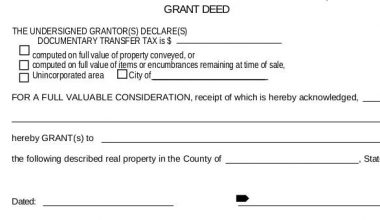There basically two categories all properties fall into; Real and personal property. For a property to be considered real or personal, it depends on if it is physically movable or not. The result reveals the difference which consequentially has a significant implication on the tax. This article will go over personal property vs real property, their features, and examples, the differences between tangible and intangible property as well as the taxability of real estate property and personal property.
What Is a Property?
There are two sorts of property: All property groups as either personal property or real property in legal terms. This difference between categories of property stems from English common law, still, modern laws still make the distinction.
The law treats various types of property differently. There are many various sorts of laws relating to personal property, as well as many different types of laws relating to real property.
Personal property is anything that can be moved. It’s anything that can be owned, with the exception of land. Real estate is immovable property, which includes land and anything linked to it.
In most cases, a piece of property groups as either personal or real property. The distinction between the two is usually obvious. Yet, categorizing property might be difficult at times. Consider the following scenario.
Let’s imagine I get some lumber and other construction tools like a saw, a hammer, and some nails. You can consider the following properties as personal property. They’re movable, and they’re mine.
After that, I use these materials to construct a shed on my land. Is this shed a personal property? No. Because it’s joint to and now part of my land, the shed is real property. Any remaining construction materials, such as my saw and hammer, remain my personal property. Anything that is genuinely a part of the shed, on the other hand, is now real property.
Personal Property
Property refers to anything that a person can legally claim as his or her own. Possessions of any form, as long as they are movable and owned by someone, are regarded as personal property. Personal property isn’t attached to or associated with land in any way.
Chattels are the term for these movable things. Possession, gifts, lost property, abandoned property, and stolen property are all covered under the law on chattels.
Chattels include belongings of any kind of tangible property. People frequently use it to refer to tangible items like a handbag/ purse or clothing or any item that anyone can touch or feel. Some chattels, referred to as fixtures, are affixed to land and can form a part of real estate.
Personal Property: Chattels or Tangibles
Personal property comprises both tangible and intangible assets property which is worth noting. Also, note that any property that you can touch and feel is a Tangible property. In a business setting, tangible personal property refers to property, such as:
- Office furniture
- Business equipment
- Vehicles for business
- Business goods
Personal property: Intangible Property
Intangible property is the direct opposite of tangible property. in other words, It is simply a property that you cannot touch and feel. It merely concerns a legal right. The existence of such property serves as a reminder that, in legal terms, property largely relates to legal rights rather than physical objects.
For a business, intangible personal property refers to property that a business owns that is not tangible, such as:
- Stocks
- Bonds
- Intellectual property
- Money
- Franchises and licenses
- Bank accounts
- Insurance policies
Real Property
Basically, real property is one that attaches to Land, or items. As a result, you can also refer to land sometimes as real estate or realty. While materials like wood, metal, and other building materials aren’t real property in and of themselves, they can become real property when joined to land. Land-based vegetation, such as trees and plants, can also be considered real property. Crops, for example, may not be considered real property because they require routine cultivation or work.
As a result, when anyone mentions real property, they are referring to land, a house, a structure, and mineral interests. As previously stated, all materials used to construct any structure that is attached to a piece of land are considered real property. Consequentially, the most important thing to understand is that real property is land and everything that is related to it. Real property, often known as real estate, is a type of fixed property that cannot be transferred. Farm structures, for example, are real property since they are joint with the land.
Personal Property vs Real Property
The next step is to define the differences between the two kinds of properties we’ve just talked about. Although numerous differences have arisen in trying to explain the definitions of the two forms of property, we will detail those distinctions below. The following are the main distinctions between personal and real property.
- Real property includes a house, walls, blinds, windows, fixtures, doors, and more that are permanently joint to the land and are immovable. Personal property, on the other hand, such as furniture, artwork, light fixtures, and other items, are movable or removable from a home or business.
- Personal property is both tangible and intangible, whereas real property is mostly tangible.
- Real Property is long-lasting and sturdy, whereas personal property may not always be.
- When it comes to personal property, it’s simple. if it’s not real property, then it’s personal property.
- Real and personal property are ran in different ways in legal terms.
- Real property cannot hide, but personal property may.
Personal Property vs Real Property Examples
Personal Property Examples
Examples of tangible personal property are the following
- Equipment
- Furniture
- Tools and
- Computers
- Vehicles
- Boats
- collectibles.
Examples of intangible personal property are as follows
- Stocks
- Bonds
- Bank accounts
- Intellectual property
- Money
- Franchises and licenses
- Insurance policies
Real Property Example
Examples of real property include the following
- Buildings
- Canals
- Crops
- Fences
- Land
- Landscaping
- Machinery
- Minerals
- Ponds
- Railroad tracks
- Roads
Real Estate vs Real Property
Although real estate and real property seem quite similar and have a lot in common, there are some significant differences between the two ideas. Understanding these nuances might help you better grasp the nuances of the land you possess and how you own it. While the phrase “real estate” frequently refers to land, the term “real property” goes a step further and explores the rights that come with that land.
The term “real estate” refers to the physical land, structures, and resources that it associates with it. While real property refers to the physical property of real estate, it also refers to a collection of ownership and usage rights.
Real Estate
Real estate is simply a plot of land with any natural or artificial—man-made—improvements attached or added to it. Trees, water, precious mineral reserves, and oil are examples of natural attachments to the ground. Buildings, walkways, and fences are examples of artificial enhancements. There are two main types of property. They are: Residential and commercial real estate
Residential real estate is property meant for human residence by a single-family or multiple families. Real estate may be leased or owner-occupied, however, the term residential real estate most typically refers to property that is leased.
Commercial real estate has its focuses on business use. This property category comprises office buildings, shops, and eateries. One can own or lease out commercial property.
Real Property
Real property is a wide phrase that encompasses both the land and any structure or other improvements that attaches to it. It also includes the rights to use and enjoy certain land, and any changes made to it. A real property encompasses both real estate and a set of rights. These sets of rights refer to the organization of property rights as they pertain to real estate. In essence, it gives property owners the freedom to use their land any way they want.
Five different rights of the property owner include the following sets of rights:
- The right to Possession entails the right to occupy the property.
- Right to control entails the right to decide on other people’s interests and uses.
- The right to enjoy refers to the right to use the property without interference from others.
- Right to exclude refers to the right to refuse other people’s interests or purposes for a piece of property.
- The right to dispose of refers to the right to choose how and whether the property is sold or transferred to another party.
Tangible Personal Property vs Real Property
Physical property that you can touch, such as furniture, clothing, and automobiles, is tangible personal property. It differs from real property (or real estate) in that you can move it from one location to another, whereas real property permanently joins to a single location.
Why It Is Important to Classify Your Property
While all tangible property has historically been taxed in the United States, several states, particularly those in the Rust Belt, have eliminated or are phasing out personal property taxes in order to attract new investment and retain existing businesses. As a result, the capacity to correctly classify property as ‘real’ or ‘personal’ can typically decrease the overall tax burden.
Recategorization of certain assets might provide further tax benefits, as short-lived personal property can be depreciated more quickly than long-lived real estate assets. In rare cases, the categorization procedure can identify instances where a property has been taxed twice by the local government or has been withheld from taxes mistakenly.
For property owners looking to reduce their tax liability, reexamining the category of real and personal property can frequently be a beneficial process.
How to classify a property
It’s usually easy to tell whether a piece of property is real or personal. However, there are certain gray areas when it comes to classifying particular fixtures. A fixture is an item that was formerly personal property but now joins to real property in some way. Because they now join, they are usually classified as real estate.
When classifying a fixture attached with real property for tax purposes, jurisdictions often use a three-part test. The following are the three-part test:
- Occupation or Attachment: The jurisdiction looks at how the property was joint, whether it can detach, and whether doing so will create any damage to the real property.
- Adaptation: The jurisdiction examines the property’s use in relation to the rest of the real property.
- Intent: The jurisdiction determines whether the property installation intends to permanently attach to the real estate or if the use of the real property changes the fixture’s intention.
Distinguish the Taxability of Personal and Real Properties
With that said, While properties such as agricultural, commercial, industrial, residential, and utility properties are all subject to real property taxes only business-related property is subject to personal property taxes.
Personal Property vs Real Property Tax
A lot of people use the term “property taxes” when they talk about real estate taxes they pay on their homes or land. Yet, Many types of property can be owned by one person, and each type of property is taxed in a different way.
What Is Real Property Tax?
The terms “real estate taxes” and “real property taxes” are interchangeable. Most properties in the United States are subject to these taxes, which are paid to state and local governments. Real property taxes (sometimes known as real estate taxes) are commonly used to help pay for local and state services.
What Is Personal Property Tax?
Personal property is subject to a tax known as “personal property tax,” which is not the same as income tax.
Real Property Tax vs Personal Property
Personal property taxes encompass both tangible and movable personal property, such as transportation vehicles, while real estate taxes solely cover taxes on real property such as a condo, home, or rental property (like cars, planes, boats, trailers, or mobile homes). Personal property tax applies to different types of personal property depending on the state. A mobile house is a real property rather than personal property in certain circumstances situations.
Intangible personal property is exempt from personal property taxes; nevertheless, certain jurisdictions may tax certain business personal property goods but not the equivalent personal use items.
Conclusion
In conclusion, if you want to lower your tax burden, classifying real or personal property is a beneficial endeavor. Because there isn’t much of a difference between fixtures, you’ll need to understand the local case law and historic evaluation practices. You might also want to talk to a tax or financial counselor about getting a professional assessment of your property tax obligations.
FAQs
What is meant by real property?
Everything permanently associated with the land and the rights of ownership, including the right to acquire, sell, lease and enjoy the land is real property.
What is an example of real estate?
Vacant land and residential lots, plus the houses, outbuildings, decks, trees sewers, and fixtures within the boundaries of the property are examples of real estate. Furniture, cars, paintings, jewelry, and boats are examples of personal property rather than real estate.
What is real property quizlet?
Real property. the land, everything that is permanent on the land, and everything that is appurtenant to the land.
What is an example of tangible property?
Tangible personal property exists physically (i.e you can touch it) Clothing, vehicles, jewelry, and business equipment are examples of tangible personal property.






